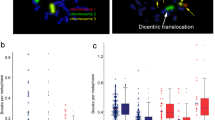Background and Purpose:
Analysis of radiation-induced chromosomal aberrations is regarded as the “gold standard” for classifying individual radiosensitivity. A variety of different parameters can be used. The crucial question, however, is to explore which parameter is suited best to describe the differences between patients with increased radiosensitivity and healthy individuals.
Patients and Methods:
In this study, five patients with severe radiation-induced late effects of at least grade 3, classified according to the Radiation Therapy Oncology Group (RTOG), and eleven healthy individuals were examined retrospectively. Peripheral blood lymphocytes were irradiated in vitro with 0.7 Gy and 2.0 Gy prior to cultivation and stained by means of three-color fluorescence in situ hybridization (FISH). The detailed analysis was focused on the number of breaks per metaphase, on breaks from complex chromosomal rearrangements per metaphase, as well as on the percentage of translocations, dicentric chromosomes, breaks, and excess acentric fragments—each in comparison with the total number of mitoses analyzed.
Results:
Using the number of breaks from complex chromosomal rearrangements after 2.0 Gy, radiosensitive patients as endpoint were clearly to be distinguished (p = 0.001) from healthy individuals. Translocations (p = 0.001) as well as breaks per metaphase (p = 0.002) were also suitable indicators for detecting differences between patients and healthy individuals. The parameters “percentage of dicentric chromosomes”, “breaks”, and “excess acentric fragments” in comparison to the total number of mitoses analyzed could neither serve as meaningful nor as significant criteria, since they showed a strong interindividual variability.
Conclusion:
To detect a difference in chromosomal aberrations between healthy and radiosensitive individuals, the parameters “frequency of breaks per metaphase”, “complex chromosomal rearrangements”, and “translocations” are most suitable.
Hintergrund und Ziel:
Die Analyse chromosomaler Aberrationen wird als „Goldstandard“ angesehen, um individuelle Strahlenempfindlichkeit zu detektieren. Eine Vielzahl von verschiedenen Parametern kann verwendet werden. Die Frage stellt sich, welche Parameter die Unterschiede zwischen Patienten mit erhöhter Strahlenempfindlichkeit und Kontrollpersonen am besten detektieren.
Patienten und Methodik:
Retrospektiv wurden fünf Patienten mit klinisch manifestem Strahlenempfindlichkeitssyndrom (RTOGGrad 3) und elf gesunde Kontrollpersonen untersucht. Dabei wurden periphere Blutlymphozyten vor der Kultivierung mit 0,7 Gy und 2,0 Gy bestrahlt und mittels Drei-Farb-Fluoreszenz-in-situ-Hybridisierung (FISH) angefärbt. Die Analyse bezog sich auf die Anzahl der Brüche pro Metaphase, die Anzahl der komplexen Aberrationen pro Metaphase sowie auf den Anteil von Translokationen, dizentrischen Chromosomen, Brüchen und zusätzlichen azentrischen Fragmenten an der Gesamtzahl der analysierten Mitosen.
Ergebnisse:
Mit Hilfe des Parameters „Brüche aus komplexen Aberrationen pro Metaphase“ bei 2 Gy konnten erhöht strahlenempfindliche Patienten als Endpunkt klar von Kontrollen unterschieden werden (p = 0,001). Des Weiteren waren sowohl Translokationen (p = 0,001) als auch Brüche pro Mitose (p = 0,002) geeignete Indikatoren für die Unterscheidung von Kontrollpersonen und erhöht strahlenempfindlichen Patienten. Die Parameter „Anteil der dizentrischen Chromosomen“, „Anteil der Brüche“ und „Anteil der zusätzlichen azentrischen Fragmente“—alle bezogen auf die Gesamtzahl der analysierten Mitosen—konnten nicht als signifikante Kriterien herangezogen werden, da sie eine große interindividuelle Variabilität zeigten.
Schlussfolgerung:
Um einen Unterschied in den chromosomalen Aberrationen zwischen Kontrollpersonen und erhöht strahlenempfindlichen Individuen darzustellen, sind die Parameter „Brüche pro Metaphase“, „komplexe chromosomale Aberrationen“ und „Translokationen“ am besten geeignet.
Similar content being viewed by others
Author information
Authors and Affiliations
Corresponding author
Rights and permissions
About this article
Cite this article
Keller, U., Kuechler, A., Liehr, T. et al. Impact of Various Parameters in Detecting Chromosomal Aberrations by FISH to Describe Radiosensitivity. Strahlenther Onkol 180, 289–296 (2004). https://doi.org/10.1007/s00066-004-1200-y
Received:
Accepted:
Issue Date:
DOI: https://doi.org/10.1007/s00066-004-1200-y
Key Words:
- Hypersensitivity
- Ionizing radiation
- Chromosomal aberrations
- Complex aberrations
- Fluorescence in situ hybridization (FISH)




